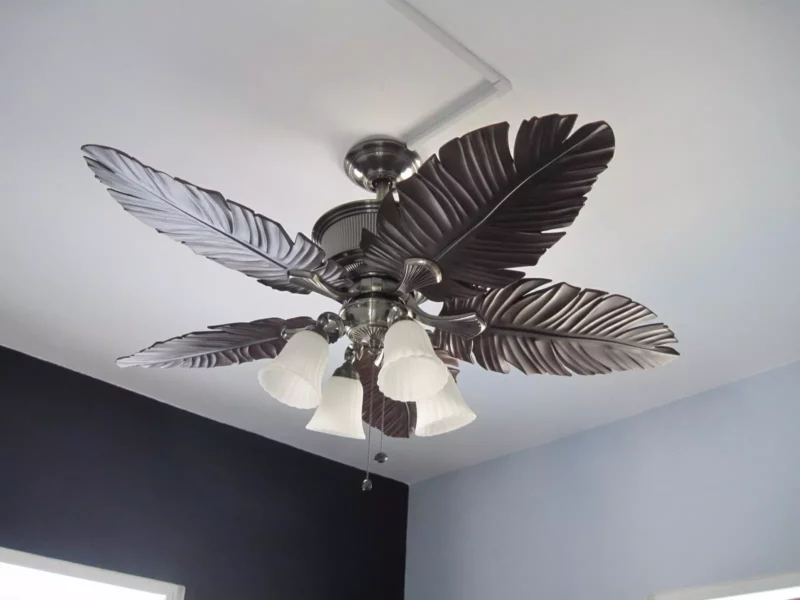What Should Be Considered When Buying a Ceiling Fan?

Check that the ceiling fan is running quietly
The noise that some models create can become especially unpleasant over time. Therefore, it is necessary to understand the sound level of the device, which should be more than 40 dB. (This data is written by manufacturers on the packaging)
Check that the blades have a good slope
What makes the best ceiling fan is not the number of blades, but the degree of their inclination, it is recommended to choose a model with an inclination of 6 to 18 degrees.
Check that the ceiling fan is assembled from good materials
In addition to the decorative aspect, the material must be carefully chosen depending on the place where it will be installed. Materials that are easy to care for and resistant to the vagaries of the weather should be preferred, especially when ceiling fans are intended for industry or agriculture.
Be sure to install the ceiling fan correctly
The quality of installation and fastening is very important. Poor fixation can create noise, installation requires knowledge of electricity.
Depending on the use (summer and/or winter), attention should be paid to the quality of the materials and the quality of the engine materials. Some manufacturers offer lifetime motor warranties or longer warranties.
How to buy a good ceiling fan?
Material: The material of a ceiling fan, whether plastic, aluminum or stainless steel, is tested for strength and stability.
Max power: The maximum power differs from device to device. Therefore, it is an important criterion for establishing a comparison.
Quality of education: Reviews often show that the quality of the manual is fundamental and must be considered when evaluating a ceiling fan.
Height: Height measurement after installation is one of the commonly performed tests.
Weight: Since this is a suspended element that needs to be fixed at height, the weight is a necessary information to take into account during the testing phases.
Diameter: The diameter of the blades is checked to determine, in particular, its compliance with that specified by the manufacturer.
Timer: The presence of a timer on the ceiling fan is a feature that is the subject of tests and comparisons.
Maximum wind speed: Wind speed is one of the criteria tested. Defined in m/s.
Standby power consumption: The consumption of the device in the off state is included in the grid of tests carried out by professionals.
Maximum sound volume: Sound volume is a decisive criterion when buying. Therefore, this test passes natural tests.
FAQ
How noisy is the ceiling fan?
- Most modern appliances are designed to be quiet. However, some of them become noisy due to poor installation or when the maximum speeds are turned on. That is why it is necessary to pay great attention to assembly and devices whose performance does not require the use of maximum power.
Does a ceiling fan lower the temperature in a room?
- The fan does not cool the room, but creates air currents. Therefore, the fan acts more on the perceived temperature than on the actual room temperature.
Can you install a ceiling fan yourself?
- With a good knowledge of electricity and the ability to needlework, you can install a ceiling fan yourself. The quality of the assembly instructions is of particular importance.
What does the winter function of the ceiling fan do?
- The winter function of the fan makes it possible to better distribute the heat supplied by the heaters and thereby heat the room. Hot air tends to accumulate towards the ceiling.
Can a ceiling fan be installed in the bedroom?
- Fan installation is possible in all rooms, including the bedroom. Some models, which are not very noisy, are specially adapted for this type of room.
How to install a ceiling fan on an inclined support?
- It is appropriate to use a special bracket on the sloping surface to fix on the sloping ceiling. This bracket will provide a level surface on which to hang the fan.
How to clean and maintain a fan?
- It is enough to regularly wipe the blades with a damp cotton or microfiber cloth. You can also use a vacuum cleaner or a vacuum cleaner with a long handle if the fan is difficult to access.
Can you leave the ceiling fan on?
- Although a ceiling fan consumes less energy than an air conditioner, it still has a motor that generates heat when used for a long time. Like any electrical device, it should only be used when needed and the engine should be allowed to cool down regularly to ensure a longer device life.
What is the maximum area for installing a ceiling fan?
- The ceiling fan is effective for rooms up to 35 m². However, for rooms with a very large area, nothing prohibits the installation of several devices.



